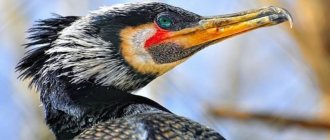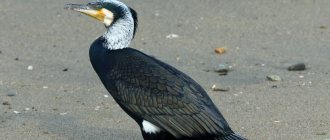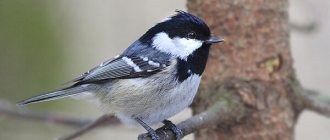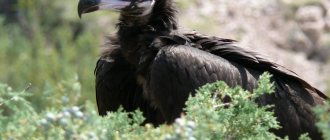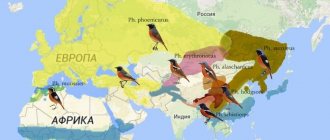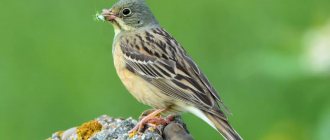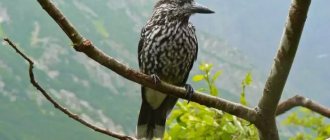Description and features
When it comes to the cormorant bird, the association “bird-fisher” immediately comes to mind for many! Indeed, we can say that cormorants rightfully deserve this unspoken nickname. They won it with dignity and confidence thanks to their colossal fishing skills.
The cormorant bird belongs to the cormorant family and belongs to seabirds. There are varieties of cormorants: crested, little black cormorant , great and many others.
In Latin the name of the bird is written as "Phalacrocorax". The sizes of cormorants vary. Some are similar in size, for example, to the merganser from the duck family; others will be larger. In any case, the length of the birds' bodies varies approximately from half a meter to one.
Some fly quickly, in a straight path. If they have to take off from the water surface, they run up and accelerate. The wingspan of cormorants can reach over one and a half meters. On average, the indicators fit into frames from eighty to one hundred and sixty centimeters.
The appearance of the cormorant varies. In color, adult cormorants are mostly dark: black, black and white (with a predominance of black), brownish, etc. It can be difficult to distinguish a male cormorant from a female due to the fact that they look very similar. Anyone can verify this by looking at what the cormorant in the photo .
Ornithologists who study birds of this genus are well aware of the insufficiently expressed visual differences between female and male birds; in their work and research activities they often encounter real individuals. As you know, with visual examples, learning any material is easier!
The sea cormorant has a long, hooked beak without nostrils. The paws contain membranes. The cormorant lives preferably in marine areas, but can also live on lakes.
How to determine the sex of a Seagull?
Thus, on average, males are larger than females, and their heads appear more powerful. The forehead of females is higher than that of males, which gives the head some roundness and gives females an expression of somewhat greater meekness compared to males, whose forehead is flattened and looks like a continuation of the beak.
Interesting materials:
Why isn't Nathan doing Misfits anymore? Why the Bad Apartment Master and Margarita? Why are some emoticons not displayed on Instagram? Why can't you whitewash trees? Why can't you take reeds home? Why can't you adopt a puppy per month? Why can't you tow a car with a CVT? Why can't you peel beets before cooking? Why can't you give white slippers? Why can't you give your own veil?
Types of cormorants
There are various genera of cormorants (including small cormorants), and birds are also classified by species. There are only about forty species. Among them are the Indian, crested cormorant, great, small spotted cormorant, Bering, Galapagos, eared cormorant and others. Let's look at some of them in more detail.
The Indian cormorant, for example, is one of the smallest cormorant species. Lives on the Indochina Peninsula, o. Sri Lanka; its home is also India, Pakistan, etc. It feeds on fish. To get food for itself, it skillfully and deftly dives, briskly pursuing prey right under water.
The adult Crested Cormorant is a medium-sized black bird, approximately seventy centimeters long, with a graceful, pointed beak about five to six centimeters in length. The crested cormorant is great at diving and swims expertly.
But it doesn't fly very well. The flight looks difficult and does not last long. Like other cormorants, it eats fish. It prefers to catch it near the bottom. So in the distant expanses of the sea, under which there are impressive layers of water and the bottom is “too low”, you will not find it.
The great cormorant (also known as Black Sea cormorant , as some call it, in connection with one of the bird’s habitats) happily settles down on rocky surfaces. Birds love to spend time together and often gather together in fairly large numbers.
Cormorants of this species like to hunt cooperatively, finding fish in the sea and then “driving” them to shallower areas. The parental behavior of birds is interesting: representatives of both sexes take care of incubating the eggs: both females and males!
It’s unusual to think that a “father cormorant” can sit in a nest for warming eggs instead of a “mother.” Nevertheless, this is what happens. One of the most unique representatives of the cormorant is the white-breasted cormorant . The plumage of the chest is light, white or grayish. The bird is called one of the rarest species of cormorants.
The adult Bering cormorant is a "metallic black" bird with a crest of longer feathers on its head. Lives in Kamchatka, Chukotka, North America and other places. It flies well, even over impressive distances (it goes to open sea waters to fish), but on land it looks clumsy.
The Galapagos cormorant is special among its kind. Unlike others, it does not fly due to its extremely short wings! It looks somewhat like a duck. Despite its “disadvantage” in terms of flying abilities, the Galapagos cormorant swims excellently.
Features of character and lifestyle
Photo: Black Cormorant
Cormorants, having found fishing spots, will constantly return there. Interesting fact: the cormorant can hunt and live both near sea water and fresh water; the most important thing for them is to nest near a body of water. Small species of these birds can even live on bolts, having great agility due to their size.
The cormorant is not picky in choosing a place to build a nest; it can build them both on trees and on rocks, in reeds, even just on the ground. They create nests from branches, sticks and leaves. All types of cormorants are collective birds and usually settle in quite impressive colonies; this is done for more successful hunting and for the safety of their offspring.
These birds love their neighbors, so they willingly live near any population of birds, as well as penguins or fur seals. It is extremely rare to see settlements exclusively of cormorants, most likely this will not last long and very soon the long-awaited neighbors will move in. Also, they often allow other birds to hunt together. Cormorants are agile only in water; on land they are completely opposite creatures that are not comfortable to move around.
Interesting fact: Cormorants cannot take off from flat ground, they must take a running start; they usually take off from the surface of the water, but this also requires a lot of effort from them; the easiest way for them is to fly from the branches of trees or rocks.
Lifestyle and habitat
The cormorant is a supporter of active life during the daytime. What is the daytime part of their life like? The cormorant bird most of its day near or on the water, searching for food for its family and itself.
They show agility in catching fish, which is not surprising, because otherwise the catch would be meager or there would be none at all. Nevertheless, it is impossible not to emphasize its speed and maneuverability in the expanses of water - the bird is truly worthy of admiration.
Some species of cormorants fly to warmer climes for the winter; these are the majority. A smaller part remains in their native latitudes and leads a sedentary lifestyle. Some birds combine both characteristics, being both sedentary and partly migratory. For example, the red-faced cormorant.
Speaking about the characteristics of cormorants, I would like to emphasize again that they are quite sociable birds. They like to settle and set up nesting sites in large “groups”. Sometimes such a “society on the rock” includes only representatives of the cormorants themselves. At other times, there are also other birds present there, for example, seagulls, without which it is probably difficult to imagine any coastline.
It is interesting that the image of a cormorant appeared on various objects of art, culture, etc., for example, postage stamps, postcards, envelopes. Clothes with the image of a cormorant look impressive and unusual: T-shirts, dresses, etc.
Natural enemies of cormorants
Photo: Cormorant in flight
The cormorant is a social, trusting bird, and this is what most often plays a cruel joke on them. The gray raven is one of the sworn enemies of the cormorant; they usually act together, one individual lures an adult cormorant out of the nest, and the second at this time steals their eggs to eat together. It also happens that nearby seagulls or starlings hunt for eggs. This may be why cormorants leave destroyed clutches of eggs unfinished and create new ones.
For already hatched chicks, wild foxes, raccoons and other small predators that live in the area of the cormorant settlement are dangerous. For an adult cormorant, these enemies are not scary, since it has a powerful body and beak, it can easily fight back, but the offspring, unfortunately, suffer. Since the cormorant is not an edible bird, they are not hunted. But their babies, not yet strong and just hatched from eggs, can become a delicacy for passing fishermen or hunters.
The tendency to have a large population is most likely due to the opportunity to preserve as many chicks as possible. There are even entire species of cormorants that are protected because they cannot reproduce, their nests are constantly destroyed, for example, the Crested and Little Cormorants.
Nutrition
A little about the nutrition of cormorants was discussed above, let’s look at the issue in more detail. The main “component” of the daily diet is, of course, medium-sized and also small-sized fish. Birds of this family welcome sardines, herring, and do not refuse capelin and others.
Despite the fact that cormorants feed on fish, it is not the only type of food for the family. They can eat crustaceans, starfish, etc. Some even eat frogs and snakes, turtles, and insects.
But let's get back to the fish. After fishing, which, as is known, is carried out by vigorously diving under water, cormorants have to spend some time on land: the shore, rocks or stones, so that their wings can dry.
The cormorant can often be seen in exactly this position, this is how the bird dries its feathers
Looking at bird nutrition more specifically, the following can be noted. Great cormorant , for example, dives for fish no deeper than four meters. The flight distance to which it “dares” to get food in the sea does not exceed on average fifty kilometers when viewed from land.
The fish that large cormorants usually choose are about a couple of tens of centimeters in length. Birds hunt while afloat, initially positioning themselves on the surface of the water and carefully concentrating on the search. Then they make a sharp jerk down. They hit the fish sharply on the side, grab it with the beak, and then remove it from the water.
The crested cormorant , by comparison, can dive much deeper for the desired prey than the great one! The crested cormorant (also called the long-nosed cormorant) can dive forty meters or even more.
It eats gobies, cod, eels, herring, etc., depending on its habitat. Apart from fish, he doesn’t particularly like anything, except that, as an exception, he may pay attention to a crustacean or mollusk.
Eared cormorants are precisely those who, if something happens, will not mind profiting from amphibians or crustaceans. They may eat insects. However, the preferred type of food for them, of course, remains fish. To obtain food, they choose shallower water areas, up to eight meters deep. They don’t want to go further than five kilometers deep into the sea.
Cormorants: description
The cormorant family consists of almost 40 species of birds, which represent a species of aquatic birds that are part of the pelican order. Like all other species of birds whose life activity is connected with the expanses of water, cormorants have membranes between their toes. This paw structure provides these birds with comfortable living conditions on the surface of the water.
These birds easily dive to a depth of 15 meters to feed, while their livelihoods are associated with the coastal zone. Cormorants make their nests in different places: in trees, among rocks, on the shore, and also on small hills (on hills). Cormorants are considered relatively large birds with relatively large limbs. Adults grow from half a meter to 1 meter in length. The wingspan of these birds reaches one and a half meters.
Cormorant - interesting facts
Appearance
Most varieties are characterized by the presence of dark iridescent feathers, which can have a metallic, golden or greenish tint, depending on the nature of the light, as well as the presence of a long beak, curved like a hook at the end. Some individuals are distinguished by the presence of lighter shades on their plumage. For example, the chest area may appear whitish or grayish in color. Cormorant chicks, when born, have a light brown plumage color, but as they grow older, the color of the plumage takes on new shades.
Interesting moment! At first glance, especially if you lack skills, it is simply impossible to distinguish between a male and a female cormorant. In fact, males are larger than females, which is noticeable visually.
The body of cormorants is stocky and dense, while the neck is elongated, so you can often see this bird standing with its head raised, which rests on its neck, located almost vertically. These birds move on land with a characteristic gait, clumsily waddling from side to side, but they are excellent flyers and excellent swimmers.
Character and lifestyle
These birds lead an active lifestyle during the daytime, and at night they rest (sleep). Their sedentary behavior depends on the nature of their natural habitats, so cormorants can also be migratory birds. These birds prefer to live in numerous colonies, which allows them to survive in difficult natural conditions. Living in groups, they actively protect their living space from attacks by various types of predators. Under such conditions, there is a high probability that the resulting offspring will not end up in the teeth or paws of various predatory animals or birds. Their colonies are located in the vicinity of other species of birds or animals, which indicates the friendly nature of cormorants in relation to other representatives of wildlife. Therefore, they can be seen next to seagulls, next to penguins or next to fur seals.
As a rule, the cormorant nest is located on a significant elevation, such as the tops of trees or the tops of coastal cliffs, although nests can be seen directly on the surface of the ground. Various branches and leaves, as well as other elements that come into the field of view of these birds and are suitable for arranging the nest, are used as building material for the nest.
The entire life of cormorants is connected with sea areas, which serve as a source of food for these birds. It should be noted that they feel great both on the surface of the water and in its thickness, being under water for up to 15 minutes. Possessing an excellent reaction, they instantly find themselves in the water column, without creating extraneous noise, and they do this with great care, regardless of where they dive from - from the water surface or from the shore. In addition, they have excellent fishing skills. They drive small fish in schools closer to the shore, after which they disassemble the schools of fish into components with their entire family.
How long do cormorants live?
The indigenous inhabitants of the coastal areas, paying attention to the dexterity of these birds, decided to use the capabilities of these birds for their own purposes. They caught cormorants and put a narrow ring around their necks, and a long rope was tied to it. The bird could catch fish, but could not escape. The cormorant caught fish because hunger forced him to do so, but he could not swallow it because the ring on his neck was in the way. The bird had no choice but to free the fish from its beak. Nowadays, such treatment of these birds is not practiced, and such practice looks terrifying. One of the cormorants, which caught fish for humans in a similar way, lived for two decades.
Types of cormorants
The territory of our country is mainly inhabited by great cormorants, but there are also other types of cormorants, such as Bering, red-faced, Japanese, crested and small cormorants. The smallest representative of this family is the Bering cormorant. It is distinguished by its original plumage color, with the presence of black, green and other shades. The back area has a purple tint. After the first ice appears, they move to warmer regions for the winter. They return back as soon as the first ice movement begins.
Little cormorants prefer to live in marshy areas. Although they are small, they are quite agile birds. The chest area is painted in reddish-brown tones, and the back area has a metallic green tint.
Red-faced cormorants prefer to live on the coasts and island territories of northeast Asia, as well as on the shores of North America. It differs from other varieties of cormorants in having a larger and lighter beak.
Interesting to know! Steller's cormorants are considered extinct. They represented flightless birds that ended up on the shore only to breed their offspring. It was a fairly large species, with a body weight of up to 6 kilograms.
In addition to those noted earlier in the text, there are species such as the reed cormorant, the royal cormorant, the Antarctic blue-eyed cormorant, the Campbell cormorant and other species known to modern science.
Where do cormorants live?
The habitat of these birds is quite extensive, so it is difficult to say which part of the world or country is the homeland of these birds. Cormorants are also found on the territory of our country. Living on sea coasts, these birds are accustomed to real heat and bone-chilling cold. There are 6 species found in our country, with the great cormorant being the most common.
Interesting moment! This bird also lives on the Australian continent almost everywhere, with the exception of areas occupied by mangroves, as well as areas located in the tropics. Also found on the Lesser Sunda Islands.
What do cormorants eat?
The basis of the diet of cormorants is small fish, such as herring, sardines and capelin. On occasion, a cormorant can dine on a frog or a reptile in the form of a snake. Birds hunt in whole groups. An adult fish needs to catch and eat up to half a kilogram of fish per day. In this regard, cormorants are considered very inconvenient neighbors for humans, since they eat part of the fish, and a considerable one.
Reproduction and offspring
Species that lead a sedentary lifestyle acquire a soulmate around the month of May. As for migratory species, they return to their usual nesting sites in pairs. Experts believe that cormorants choose a soul mate for life. Having built a nest, the female lays up to 6 eggs in it over several days. Almost helpless offspring are born that need parental care for 6 months.
Important point! When it is too hot outside, cormorants remain in the nest, covering their chicks with their wings to protect them from the scorching sun. To make the heat not seem so sultry, cormorants bring wet algae to the nest.
Under such weather conditions, cormorants hunt either early in the morning or late in the evening. The chicks are fed from processed food that is regurgitated by the parents, while both parents feed the chicks. The offspring can be under the care of their parents until they are 2–4 years old, until the young cormorants start their own family.
Natural enemies
Adult cormorants have practically no natural enemies, but their offspring are absolutely defenseless against many predatory animals and birds of prey. Many birds destroy the nests of cormorants, and they skillfully steal eggs from their nests.
Reproduction
Cormorants are thoroughly preparing to replenish their family. Nests are carefully prepared, which are made from twigs, etc. cormorant nest is usually located on the branches of a tree, but sometimes they can be found in reeds and other places.
Chicks mature and grow in eggs on average for twenty to thirty days. Considering that the female cormorant does not lay all the eggs at once, but one at a time, it is easy to understand why the hatched, “newly arrived” birds, being equally smooth, without feathers, and defenseless, are so different in size!
Speaking about the reproduction of cormorants more specifically, let us give an example with the Indian cormorant. This bird usually lays three, four or more eggs (the number can reach up to six). The chicks are born naked, without feathers. Later, fluff grows on them, then feathers appear.
The Bering cormorant chooses protective, secluded places for nesting, such as crevices and cracks in rocks, and others. The nests are large and spacious. As a rule, it lays three or four eggs, but there are other, less common cases when there may be a different number of eggs in the clutch: less, more.
As in the case of the Indian species of cormorant, the offspring are born completely devoid of any plumage, even down. Only after some time do the babies acquire their first “clothes” of gray color.
Social structure and reproduction
Photo: Cormorant bird
This species of bird is monogamous; once it creates a pair, it can live with it for the rest of its life. Cormorants are very prolific. They reach sexual maturity at about 3 years of age, depending on the variety, once they are mature they have an adult plumage. The mating season is mainly in the spring, as it becomes warmer, but in some regions there are exceptions.
Cormorants settle in colonies; they can reach enormous sizes, up to 2000 nests. Sometimes, when organizing such large settlements, they unite with families of other birds living in the neighborhood. The female lays up to 6 eggs, but this is the maximum, so one of them may be empty. The eggs are blue in color and are hatched by the two parents in turn. Incubation lasts about a month.
When the long-awaited offspring is born, the parents also take care of them together, replacing the protection of the chicks with obtaining food and water for them. Cormorants feed children in the morning and evening. The chicks are born naked and completely defenseless, so parents are forced to stay close to them around the clock. They cover the chicks with their wings from the hot sun, and in some cases they bring cold seaweed to the nest.
Up to six months, babies need care; when their first plumage appears, they try to fly, but this is not always successful. If the nest is located in a tree, then the young hone their crawling and climbing skills. It happens that cormorants turn out to be such caring parents that they feed their offspring even until they start their own family.
Lifespan
The lifespan of cormorants can vary. On average, in the wild, cormorants can live up to about eighteen years or a little more. At the same time, if we take a specific type of cormorant, for example, the eared cormorant, then in natural conditions it lives on average about six years.
Range, habitats
If we talk about which country is the homeland or main refuge for cormorants, it is difficult to answer this question. They inhabit almost the entire globe, including they can be found on the territory of the Russian Federation.
Sea coasts do not frighten cormorants either with scorching heat or piercing cold. Our country is currently home to as many as six species, among which the Great Cormorant is considered the most common.
The bird is also distributed throughout Australia, with the exception of wet coastal mangroves and tropical forests. Also inhabits the Lesser Sunda Islands.
An interesting custom involving the cormorant bird
Nowadays, some cormorants are known to live in zoos. This is one of the types of “communication” between a modern cormorant and a person. Previously, cormorants were also in “communication” with people. Only then the “interaction” looked different.
They say that in the old days there was such a custom as fishing with cormorants. This method has its roots in the distant past, its age is more than a thousand years. The method was used in countries such as China and Japan, as well as in European countries.
What was cormorant fishing like in general terms? The cormorant , known since ancient times for its fishing skills, caught fish not for itself, but for people! The man learned to “use” his skill to his advantage. It happened approximately as follows.
The bird was tamed over a period of time (about fourteen days on average). It should be noted that this process was very productive, the cormorants quickly got used to “their man,” and then “cooperation” began.
The bird was released onto the surface of the water, it began to hunt. After the dive, she swam up with the prey. But it was one thing to catch a fish, and another thing to make sure that the bird did not immediately eat the catch.
A method was invented for this: a special ring was put on the cormorant’s neck. The bird could move, fly, swim, of course, breathe and even drink. One thing: the bird could not eat. The caught fish did not pass through the “ringed throat”. But what was so difficult about chewing the prey and swallowing it piece by piece? – The answer is simple: cormorants don’t do that, they eat whole fish.
However, from time to time the birds received “their share”, since they could still swallow small fish. Plus, to encourage and maintain the “fighting spirit” of their feathered comrades, the fishermen also gave the birds small fish, thus fulfilling their “part of cooperation.”
What does a cormorant eat?
Photo: Cormorant and fish
The cormorant feeds exclusively on fish and feeds its chicks with it; it does not give preference to any particular species; rather, it depends on the location of the bird. Being carried away by hunting, he can swallow mollusks, frogs, turtles and even crayfish, in general, everything that falls into his beak during the hunt.
The Cormorant swallows small fish immediately, raising its head up, but large fish have to be eaten on the shore, although the cormorant’s beak is powerful, but it cannot cope with any catch. There are cases that a cormorant can swallow ground insects, a snake or a lizard, but this is rare. The cormorant is a diurnal bird, they usually hunt 2 times a day, one individual eats an average of 500 grams of fish, and this is only for one hunt, a kilogram per day, but sometimes more, they are disliked for their gluttony.
Hunting often takes place with their direct relatives, pelicans; they fish on the surface of the water, and cormorants in the depths. Cormorants hunt both alone and in flocks; they simply track a school of fish and drive it into shallow water, loudly flapping their wings across the water column; once aground, they mercilessly deal with it and deal with it.
Interesting fact: the cormorant can eat small pebbles to improve digestion.
Cormorants in slang
Previously, inexperienced thieves were called cormorants, but now the word has moved from the narrow “thieves’” theme into a wider sphere of use, beginning to mean a narrow-minded, awkward person. The one who is not responsible for his words, the one who has the wind in his head, only chatter on his mind. In a word, someone rather “empty” and stupid.
In contrast to this negative image, a real cormorant , which is a bird, on the contrary, as is already clear from the above, is distinguished by its special intelligence and dexterity. The cormorant bird family is diverse, and each species has something of its own, individual. A distinctive feature, characteristic, skill - in a word, something that makes him unique in his own way.
The list of species and names could go on for a long time; studying this “section” of ornithology is fascinating and informative. One can only be amazed at how amazing the surrounding nature is, the living world created in all its diversity and, at the same time, uniqueness.
Man and cormorant
For many years, fishermen in Japan and China have used members of this genus to catch fish. Today, this tradition has been preserved only as entertainment for tourists: specially trained birds dive for fish at night , and the coast is illuminated by lit torches.
In addition to the fact that this is a very beautiful and fascinating sight, the attraction also brings benefits: in a very short time you can collect a whole basket of fish. Groups of cormorants that permanently inhabit the coast or remain for the winter create many problems for local residents. The thing is that birds are very voracious and are capable of eating up to 500 grams of fish per day , and a large number of these birds in one body of water significantly reduces the number of fish in it. Guano-bird droppings from cormorants are used by humans as valuable fertilizer.
Bering cormorant
The average body length is 0.75 m. The wingspan is 1.1 m. Weight is 1.5 kg.
The feathers are painted black with a metallic tint, the skin in the beak area is dark red. There is a crest on the crown.
How to recognize a cormorant?
Cormorants are quite large birds. The maximum recorded weight can reach five kilograms. Average individuals have a mass of three to three and a half kilograms.
The length of the body varies from seventy to one hundred centimeters. Open wings can reach a length of one and a half meters.
The plumage is mostly black, dark gray, distinguished by turquoise (although brown and brown feathers are sometimes found). The tail is long.
The cormorant's beak is especially distinctive: it is beige-brown, with a yellow spot on the bottom; the beak has an end curved towards the bottom, which makes it very easy to catch fish.
According to its anatomical structure, the beak expands by more than 140 degrees, which allows the cormorant to swallow large fish whole.
The neck is long - this is clearly visible in standard photos of the cormorant. The bird's eye area is devoid of feathers.
The cormorant's feet are webbed, similar to those of a duck, and black in color. The membranous structure allows you to feel comfortable in the water element and swim.
The description of the cormorant bird does not include all the varieties of its appearance, but is quite typical for its most widely represented individuals.
The cormorant's vocal signals resemble croaks or hoarse moans.- Winter birds | Wintering birds
Owl - habitat, characteristics of species, family, diet, life expectancy (110 photos + video)
- Pigeon - types and differences, features, flight, nutrition and reproduction + 88 photos
Young cormorants have white plumage on their chests, which over time is completely replaced by black, hard feathers.
Cormorant feeding
The main diet of cormorants consists of small and medium-sized fish. But sometimes mollusks, crustaceans, frogs, lizards and snakes are used as food. The beak of these birds can open quite wide, which allows them to swallow a medium-sized fish whole, raising their head up.
On the Internet there are many videos and photos of the cormorant bird at the moment of catching and eating fish - this is quite a fascinating sight. The bird swims, lowering its head into the water and dives sharply, like a torpedo, into the depths of the reservoir, and after a few seconds it swims up 10 meters from this place with prey in its beak, tilts its head up and completely swallows the caught fish or crustacean. A large individual of this bird can eat about half a kilogram of food per day.
Appearance
As you can see in the photo of the cormorant, its size can reach up to a meter, and its wingspan varies from 0.8 to 1.5 m. The plumage is dark, iridescent, with a golden, steel or greenish tint.
The shade depends on the lighting. Some individuals have parts painted in lighter colors, for example, pale gray or white. The color of the chicks is light brown.
The cormorant's beak is long, curved, and not wide. The neck is elongated, the body is quite large. The voice of this bird is hoarse, its screams resemble groans or muffled croaks. The gait is clumsy and clumsy.
Cormorant
Length size – 0.9 m. Wingspan – 1.5 m. Body weight can range from 1.8 to 3 kg.
The plumage is black with a green tint, the throat and cheeks are white, the beak is framed by unfeathered yellow skin. There is a large black crest on the head.
Reproduction and nest arrangement
The most typical representative, the Great Cormorant, is not the most active bird in terms of migration.
Choosing mainly temperate latitudes with a cool climate, the individual settles in one geographical location, builds a nest there and chooses a mate for life.
The characteristic life in the colony helps cormorants to repel attacks of other fauna on their community and defend a territory rich in food and cozy landscapes suitable for nesting.- Crane - origin, description, habitat and lifestyle, nutrition and reproduction + 79 photos
Heron - 89 photos of a very beautiful and rare bird
- Swallow - features, lifestyle, mating season and lifespan (93 photos + video)
A mandatory presence for building a nest is the proximity of a body of water. The place itself can be either a tree or a rock. Sometimes cormorants can choose a place to hatch their offspring even in dense bushes for lack of more suitable options.
Cormorants are monogamous birds. When choosing a mate, birds remain together for the entire fifteen to twenty years of their lives, which is considered one of the longest periods among all studied types of ornithology.
Both parents build the nest. Eggs are laid in late spring in the amount of four to five eggs. The chicks are born bald and blind, and upon reaching the two-month age threshold they leave from under the parental wing. Acquaintance with the water element occurs right there.
Antarctic Blue-eyed Cormorant
Length coverage – 0.75 m. Wingspan – 1.25 m. Weight – 2.5 – 3 kg. The plumage is contrasting. The back, wings and cheeks are painted black.
The rest of the body is white. During the mating season, a crest appears on the crown of the head, and the eyelids and skin around the eyes acquire a bright blue color.
Indian cormorant
The smallest of the family. Body length - 0.63 m, weight - 800 g. The color of the back and wings is bronze-brown, the belly is black. The skin around the throat is green or dark yellow.
In conclusion, we note that, in general, the cormorant bird population is quite large, although there are two endangered species listed in the Red Book.
The small and crested cormorants are on the verge of extinction. These birds are ruined by their gullibility in other birds (ravens and seagulls).
